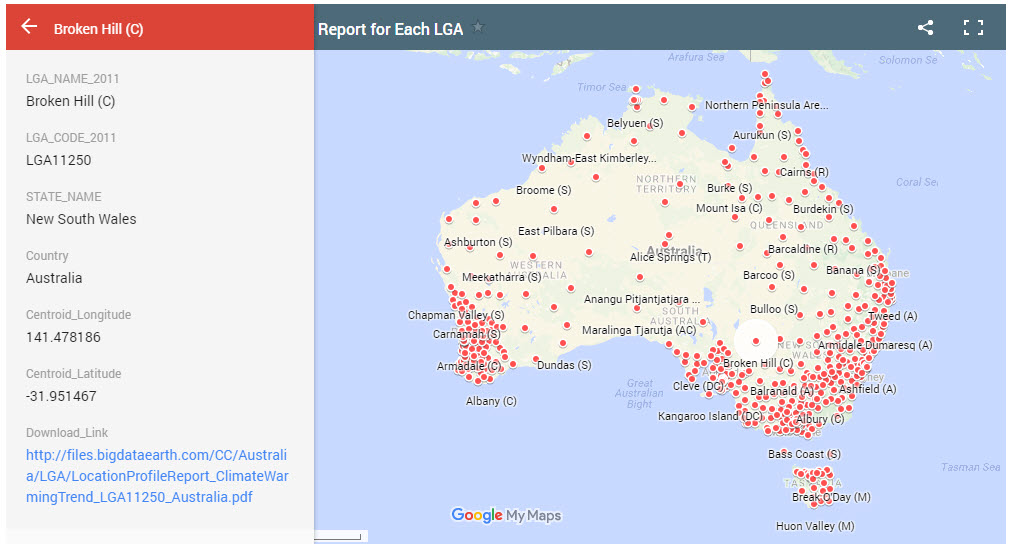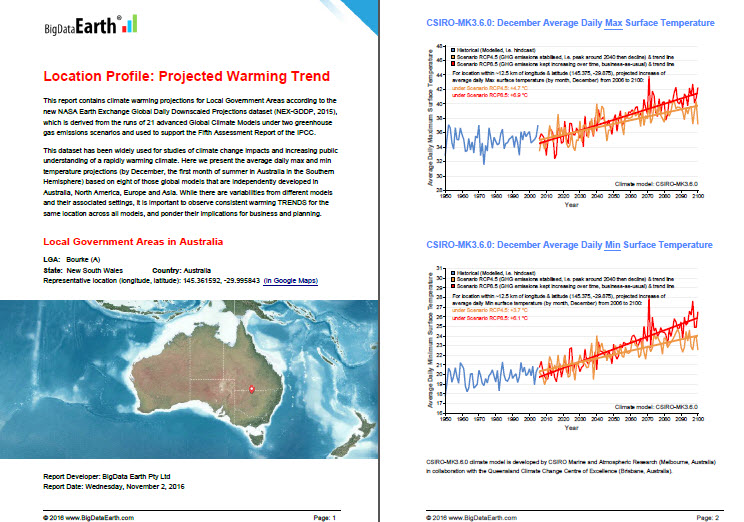As part of new asset / property location information, we are making reports on location-specific climate warming trend. It is based on the analysis of the new NASA Earth Exchange Global Daily Downscaled Projections dataset (NEX-GDDP, 2015), which is derived from the runs of 21 advanced Global Climate Models under two greenhouse gas emissions scenarios and used to support the Fifth Assessment Report of the IPCC.
This dataset has been widely used for studies of climate change impacts and increasing public understanding of a rapidly warming climate. We analyse and compare average daily max and min temperature projections (by year or by month) from eight of those global models that are independently developed in Australia, North America, Europe and Asia:
-
CSIRO-MK3.6.0: developed by CSIRO Marine and Atmospheric Research (Melbourne, Australia) in collaboration with the Queensland Climate Change Centre of Excellence (Brisbane, Australia).
-
ACCESS1.0: developed by CSIRO (Commonwealth Scientific and Industrial Research Organisation, Australia) and BOM (Bureau of Meteorology, Australia).
-
GFDL-CM3: developed by the NOAA Geophysical Fluid Dynamics Laboratory (Princeton, NJ, USA).
-
CCSM4 climate model is developed by the U.S. National Center for Atmospheric Research – NCAR (Boulder, CO, USA).
-
CNRM-CM5: developed by CNRM (Centre National de Recherches Meteorologiques, Meteo-France, Toulouse, France) and CERFACS (Centre Europeen de Recherche et de Formation Avancee en Calcul Scientifique, Toulouse, France).
-
MPI-ESM-MR: developed by the Max Planck Institute for Meteorology (MPI-M), Hamburg, Germany.
-
BNU-ESM (Earth System Model): developed by the College of Global Change and Earth System Science (GCESS), Beijing Normal University, China.
-
MIROC5 (Model for Interdisciplinary Research On Climate): developed by the Atmosphere and Ocean Research Institute (The University of Tokyo), National Institute for Environmental Studies, and Japan Agency for Marine-Earth Science and Technology.
Interested users can download two types of sample reports:
-
Warming Trend Reports for Local Government Areas in Australia (Average daily max and min temperature trends by December, 559 PDF reports available)
-
Warming Trend Reports for National Capitals of the World (Average daily max and min temperature trends by year, 222 PDF reports available)
Website: https://www.bigdataearth.com/products-and-solutions/climate-warming-trends/

Figure 1: Downloading climate warming trend report by clicking a location point on the map.

